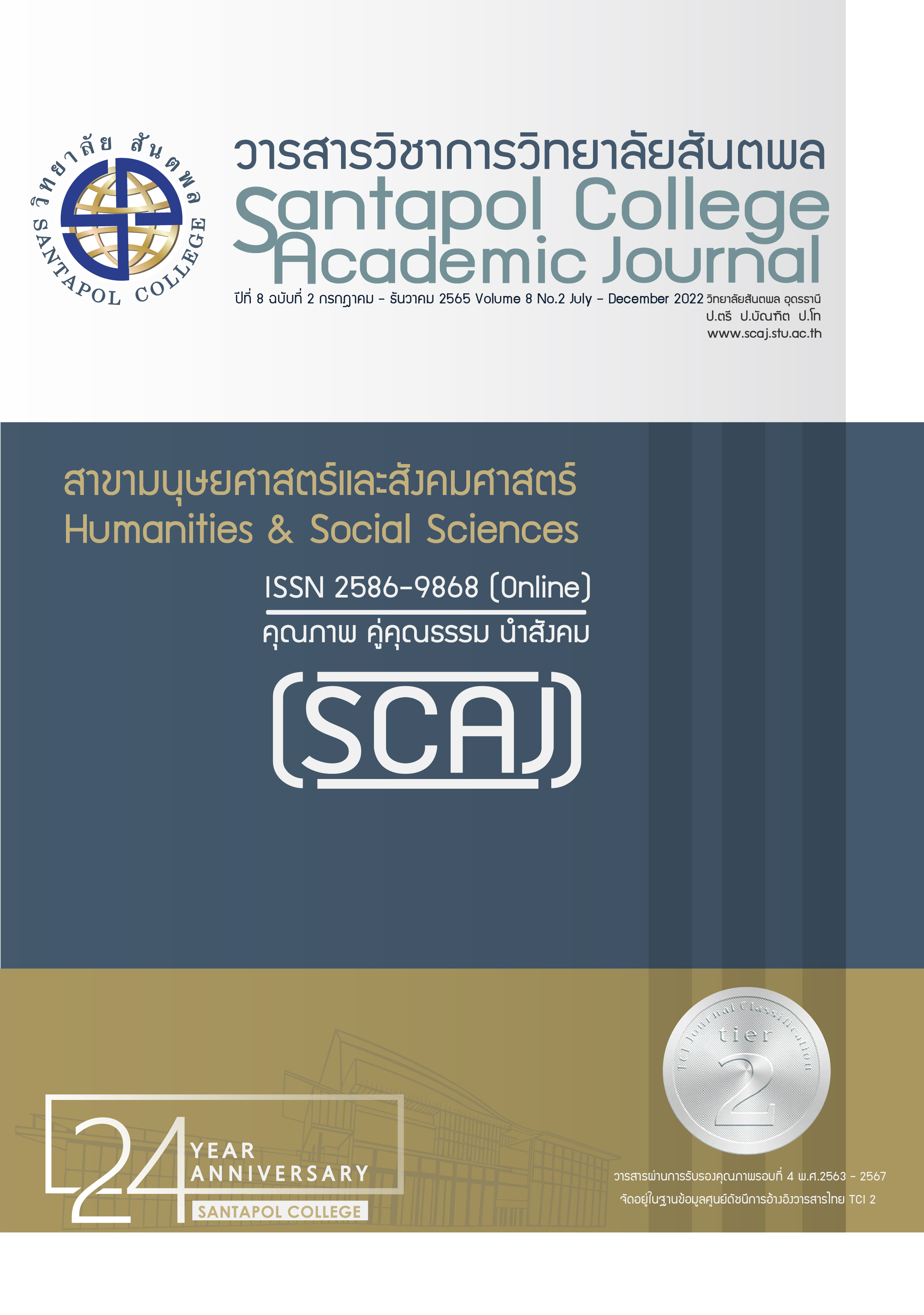ความสัมพันธ์ระหว่างการบริหารสถานศึกษาตามหลักธรรมาภิบาลของผู้บริหารสถานศึกษากับประสิทธิผลของสถานศึกษาสังกัดสำนักงานเขตพื้นที่การศึกษามัธยมศึกษาหนองคาย
Main Article Content
บทคัดย่อ
การวิจัยนี้มีวัตถุประสงค์ 1) เพื่อศึกษาการบริหารสถานศึกษาตามหลักธรรมาภิบาลของผู้บริหารสถานศึกษา 2) เพื่อศึกษาประสิทธิผลของสถานศึกษา 3) เพื่อเปรียบเทียบการบริหารสถานศึกษาตามหลักธรรมาภิบาลของผู้บริหารสถานศึกษา จำแนกตามตำแหน่งหน้าที่ และขนาดของสถานศึกษา 4) เพื่อเปรียบเทียบประสิทธิผลของสถานศึกษา จำแนกตามตำแหน่งหน้าที่ และขนาดของสถานศึกษา 5) เพื่อศึกษาความสัมพันธ์ระหว่างการบริหารสถานศึกษาตามหลักธรรมาภิบาลของผู้บริหารสถานศึกษากับประสิทธิผลของสถานศึกษา กลุ่มตัวอย่างจำนวน 291 คน ได้แก่ ผู้บริหารสถานศึกษา จำนวน 30 คน และครูผู้สอน จำนวน 261 คน ได้จากการสุ่มแบบแบ่งชั้น (Stratified Random Sampling) เครื่องมือที่ใช้ในการเก็บรวบรวมข้อมูลเป็นแบบสอบถามแบบมาตราส่วนประมาณค่า 5 ระดับ มีค่าความชื่อมั่นของแบบสอบถามทั้งฉบับเท่ากับ 0.98 สถิติที่ใช้ในการวิเคราะห์ข้อมูลได้แก่ความถี่ ร้อยละ ค่าเฉลี่ย ส่วนเบี่ยงเบนมาตรฐาน t - test (Independent Sample) F - test (One way ANOVA) และ ค่าสัมประสิทธิ์สหสัมพันธ์แบบเพียร์สัน (Pearson's Product Moment Correlation Coefficient)
ผลการวิจัยพบว่า
- การบริหารสถานศึกษาตามหลักธรรมาภิบาลของผู้บริหารสถานศึกษาภาพรวมอยู่ในระดับมาก ส่วนรายด้านพบว่าอยู่ในระดับมากที่สุดคือ ด้านหลักคุณธรรม อยู่ในระดับมากคือ หลักการกระจายอำนาจ หลักความเสมอภาค หลักความโปร่งใส หลักการตอบสนอง หลักนิติธรรม หลักการมีส่วนร่วม หลักภาระรับผิดชอบ อยู่ในระดับปานกลางคือ หลักประสิทธิผลหลักประสิทธิภาพ
- ประสิทธิผลของสถานศึกษา อยู่ในระดับมาก ทั้งในภาพรวมและรายด้าน โดยด้านที่มีระดับประสิทธิผลของสถานศึกษาสูงสุด คือ ด้านความสามารถในการปรับเปลี่ยนพัฒนาสถานศึกษา รองลงมา คือ ด้านความสามารถในการแก้ปัญหาภายในสถานศึกษา และด้านความสามารถในการพัฒนานักเรียนให้มีทัศนคติทางบวก และด้านที่ได้ระดับต่ำที่สุดคือ ด้านความสามารถในการผลิตนักเรียนให้มีผลสัมฤทธิ์ทางการเรียนสูงขึ้น
- เปรียบเทียบความคิดเห็นต่อการบริหารตามหลักธรรมาภิบาลของผู้บริหารสถานศึกษา จำแนกตามตำแหน่งหน้าที่และขนาดของสถานศึกษา แตกต่างกันอย่างมีนัยสำคัญทางสถิติที่ระดับ .01 ทั้งในภาพรวมและรายด้าน
- เปรียบเทียบความคิดเห็นต่อประสิทธิผลของสถานศึกษา จำแนกตามตำแหน่งหน้าที่ และขนาดของสถานศึกษา แตกต่างกันอย่างมีนัยสำคัญทางสถิติที่ระดับ .01 ทั้งในภาพรวมและรายด้าน
- การศึกษาความสัมพันธ์ระหว่างหลักธรรมาภิบาลของผู้บริหารสถานศึกษากับประสิทธิผลของสถานศึกษา หลักธรรมาภิบาลของผู้บริหารสถานศึกษามีความสัมพันธ์ในทางบวกกับประสิทธิผลของสถานศึกษา อย่างมีนัยสำคัญทางสถิติที่ระดับ .01 ในระดับปานกลาง
Article Details

อนุญาตภายใต้เงื่อนไข Creative Commons Attribution-NonCommercial-NoDerivatives 4.0 International License.
เนื้อหาและข้อมูลในบทความที่ลงตีพิมพ์ในวารสารวิชาการวิทยาลัยสันตพล ถือว่าเป็นข้อคิดเห็นและความรับผิดชอบของผู้เขียนบทความโดยตรง ซึ่งกองบรรณาธิการวารสารไม่จำเป็นต้องเห็นด้วยหรือรับผิดชอบใดๆ
เอกสารอ้างอิง
ขวัญพิชชา มีแก้ว. (2562). การบริหารสถานศึกษาที่ส่งผลต่อประสิทธิผลของสถานศึกษา สำนักงานเขตพื้นที่การศึกษาประถมศึกษาจันทบุรี. วิทยานิพนธ์การศึกษามหาบัณฑิต. สาขาการบริหารการศึกษา. คณะศึกษาศาสตร์ มหาวิทยาลัยราชภัฏรำไพพรรณี.
ชนิกา บรรจงปรุ. (2562). ความสัมพันธ์ระหว่างการบริหารงานวิชาการกับประสิทธิผลของสถานศึกษา สังกัดสำนักงานเขตพื้นที่การศึกษาประถมศึกษาชัยภูมิ เขต 3. วิทยานิพนธ์ครุศาสตรมหาบัณฑิต สาขาวิชาการบริหารการศึกษา บัณฑิตวิทยาลัย มหาวิทยาลัยราชภัฏสกลนคร. การบริหารการศึกษา คณะศึกษาศาสตร์ มหาวิทยาลัยศิลปากร, 2554.
ปวีณา พุ่มพวง. (2551). ความสัมพันธ์ระหว่างการบริหารจัดการสถานศึกษาแบบธรรมาภิบาลกับประสิทธิผล ของสถานศึกษา สังกัดสำนักงานเขตพื้นที่การศึกษาประถมศึกษาจันทบุรี เขต 1. วิทยานิพนธ์ การศึกษามหาบัณฑิต สาขาวิชาการบริหารการศึกษา คณะศึกษาศาสตร์ มหาวิทยาลัยบูรพา.
ปียากร หวังมหาพร. (2560). ประชารัฐจากรายการคืนความสุขให้คนในชาติคืออะไร?, วารสารการบริหารปกครอง, 6(2), 1-29.
ราชัญ สมทบ. (2558). ความสัมพันธ์ระหว่างการใช้หลักธรรมาภิบาลกับประสิทธิผลของการบริหารงานใน โรงเรียน สังกัดเทศบาลเมืองกาญจนบุรี จังหวัดกาญจนบุรี. ภาคนิพนธ์ครุศาสตร มหาบัณฑิต สาขาวิชาการบริหารการศึกษา คณะครุศาสตร์ มหาวิทยาลัยราชภัฎกาญจนบุรี.
รัตนา เหลืองาม. (2562). ภาวะผู้นำของผู้บริหารสถานศึกษาในศตวรรษที่ 21 ที่ส่งผลต่อประสิทธิผลของสถานศึกษา. วิทยานิพนธ์ปริญญาครุศาสตรมหาบัณฑิต สาขาวิชาการบริหารการศึกษา. บัณฑิตวิทยาลัย มหาวิทยาลัยราชภัฏรำไพพรรณี.
ศิราวุธ นันทะวงศ์. (2560). การบริหารงานตามหลักธรรมาภิบาลของผู้บริหารสถานศึกษาขั้นพื้นฐาน สงกัดสำนักงานศึกษาธิการจังหวัดบึงกาฬ. รายงานสืบเนื่องการประชุมระดับชาติและนานาชาติ ครั้งที่ 3. ขอนแก่น : มหาวิทยาลัยขอนแก่น.
ศิริลักษณ์ แซ่โค้ว. (2558). ความสัมพันธ์ระหว่างการใช้อำนาจของผู้บริหารกับประสิทธิผลของสถานศึกษากลุ่มศรีราชา 5 สังกัดสำนักงานเขตพื้นที่การศึกษาประถมศึกษาชลบุรี เขต 3. วิทยานิพนธ์ การศึกษามหาบัณฑิต สาขาวิชาการบริหารการศึกษา คณะศึกษาศาสตร์ มหาวิทยาลัยบูรพา.
สำนักงานเขตพื้นที่การศึกษามัธยมศึกษาหนองคาย. (2563). แผนปฏิบัติการประจำปี 2564 . หนองคาย : กลุ่มนโยบายและแผนเศรษฐกิจและสังคมแห่งชาติ ฉบับที่ 12 (พ.ศ. 2560 - 2564). (ออนไลน์). แหล่งที่มา http://www.sukhothai.go.th/mainredcross/7I.pdf. 18 สิงหาคม 2564.
สำนักงานเลขาธิการสภาการศึกษา. (2560). แผนการศึกษาแห่งชาติ พ.ศ.2560–2579. กรุงเทพฯ : บริษัทพริกหวานกราฟฟิค.
สุขุมพงษ์ ชาญนุวงศ์, อาชว์ภูริชญ์ น้อมเนียน, บุญดี มนตรีกุล ณ อยุธยา. (2559). ความยุติธรรมในมิติด้านวัฒนธรรม จริยธรรมทางศาสนา และธรรมาภิบาล. Veridian E-Journal, Silpakorn University, 9(3), 1370-1381.
อรทัย แสงทอง. (2552). หลักธรรมาภิบาลกับการบริหารสถานศึกษาสังกัดกรุงเทพมหานครกรณีศึกษาสถานศึกษาในเขตตลิ่งชัน. วิทยานิพนธ์ ปริญญารัฐประศาสนศาสตรมหาบัณฑิต สาขาวิชารัฐศาสตร์บัณฑิตวิทยาลัย จุฬาลงกรณ์มหาวิทยาลัย.
อาทิตยา สุขศรี. (2559). ความสัมพันธ์ระหว่างการบริหารโดยใช้หลักธรรมาภิบาลกับประสิทธิผลการบริหารของผู้บริหาร โรงเรียนธัญบุรี จังหวัดปทุมธานี สังกัดสำนักงานเขตพื้นที่การศึกษามัธยมศึกษา เขต 4. วิทยานิพนธ์การศึกษามหาบัณฑิต สาขาวิชาการบริหารการศึกษา คณะศึกษาศาสตร์ มหาวิทยาลัยบูรพา.
Krejcie, R. V. and Morgan, D. W. (1970). Determining Sample Size for Research Activities, Educational and Psychology Measurement, 30(3) : 607-610.
Likert, R. (1993). A Technique for the Measurement of Attitude. Chicago: Rand McNally.
Mott, P.E. (1972). The characteristic of effective organization. New York: McMillan : 398.


